Nancy Kangas moved from Columbus to San Francisco in the early 1980s. By 1983, she’d launched “Nancy’s Magazine.” Over the course of the next 13 years, she’d put out 13 issues, cementing her place in the history of the American underground press.
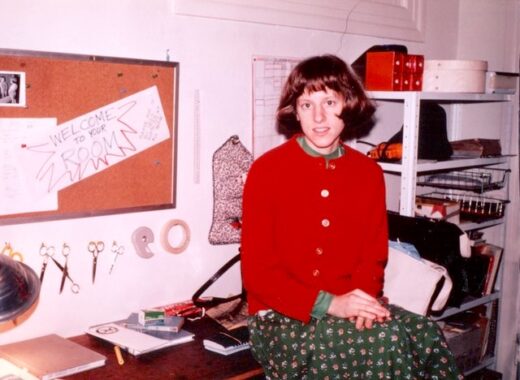
[above: Nancy Kangas in her San Francisco apartment, circa 1984.]
MARK: I’m not quite sure how, but I somehow made it through “the golden age of zines” without having read a single issue of Nancy’s Magazine. Over the years, a lot of people whom I respect, like Doug Biggert at Tower Records, and Doug Holland from Pathetic Life, have described it as being one of their favorite publications ever, but I was just never able to get my hands on a copy. So it’s always held a kind of mythical status for me. Why do you think people were so passionate about it, and still have such fond associations?
NANCY: What a nice question. Thank you. I have a sense that people were passionate about many of the early, little magazines because they came out of the lively punk-ish DIY aesthetic. They had strong authorial voices, and were super conversational. These little magazines were ready to talk TO YOU!!! What might have made Nancy’s Magazine a little different is that I wanted, and aimed for, a readable graphic design. Yes, I often violated my own rules, and packed a page too tight, and used 8-point type, but I was in love with what I thought of as elegant design — and my partner at the time, Greg Bonnell, was a huge influence. He was smitten with Swiss typography and graphic design.
MARK: How’d the first issue of the magazine come about? Was there a precipitating event of some kind, like a move to a new place…
NANCY: I had an amazing 7th grade English teacher – Mrs. Weaver at Crestview Jr. High! – who challenged us to make our own creative writing assignment. I was crazy about magazines (fan of Ranger Rick, Seventeen, Life) – and so I set about making my own. I interviewed my dad (a psychologist), and probably drew out some fashion tips, but I never finished it. So that stuck in my craw. And, yes, moving from Columbus to San Francisco probably had a lot to do with diving into a new (or long-simmering) art project.
MARK: What was it about being in San Francisco that made you think, “Now’s the time to follow through on that long-simmering desire to publish my own version of Ranger Rick?” I’m curious as to the elements that played into your decision. Did you have a lot of time on your hands? Were you looking for a way to reconnect with people that you’d left back in Columbus? Did you see it as a way to perhaps make new friends in San Francisco? Or did you just have access to a copier?
NANCY: Probably all of those reasons! – except access to the copier, which I didn’t have. Here’s another thing: in San Francisco at that time, it seemed to me that everyone I met was making something. When people asked, “So, what do you do?,” they didn’t mean, “How are you making money?” They meant, “What’s your project? What’re you working on?” I realized I really REALLY wanted to have a good answer.
MARK: How long after moving to San Francisco did you start Nancy’s Magazine?
NANCY: About a year and a half.
MARK: And when would this have been?
NANCY: 1982.
MARK: Do you remember the first piece that you wrote for Nancy’s Magazine?
NANCY: I think it was a “review” of all my dresses. I had maybe 10? I drew them all and gave a one-sentence summary of my feelings about each. It was homage to a very beloved book, “100 Dresses” by Eleanor Estes.
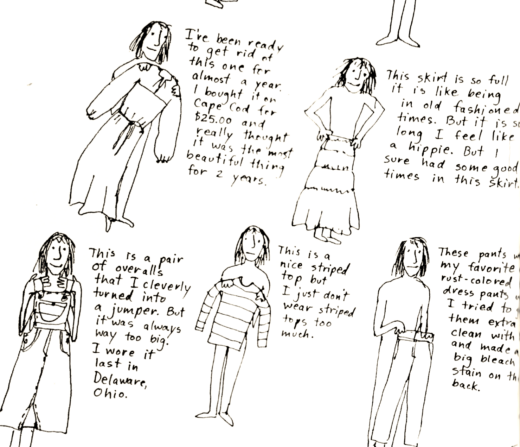
[above: Nancy’s dress review from Issue 1 of Nancy’s Magazine in 1983. Click here for a larger version of the image.]
MARK: As you didn’t have ready access to a copier, how did you handle production? Did you just save up the money and take the job to Kinko’s, or did you know someone in an office somewhere who offered to print it for you?
NANCY: I spent my money at copy shops. Later versions were printed with an offset printer – when I felt flush with cash, and craved a second color.
MARK: You mentioned the influence of your partner at the time — Greg Bonnell. What was his role, if any, at the outset?
NANCY: He cheered me on, endured being the test-guy for interviews, and contributed reviews. I bothered all the friends I could think to bother – asking for reviews, or art, or to let me interview them.
MARK: Were you interviewing new friends in San Francisco, or old friends in Ohio?
NANCY: All of the above! Sometimes involving people in your art is a way to make new friends, and sometimes it’s a way to stay connected with people you admire. (But I also know that not everyone is interested in being involved in my art projects, and I hope I’m living that knowledge.)
MARK: Can you give us an example of the kind of thing you discussed with friends in the pages of Nancy’s Magazine?
NANCY: We were fascinated with revealing the “new-ness” of what might seem to be “ordinary” – I think that’s why there’s a review of doormats and a feature on pigeons. I don’t think we would have said it in this way, but I think we wanted to talk about how amazing this world is – every little ordinary thing in it. The fact is, we were young and so much of the world WAS new! I remember the moment (about age 32) when I thought the world was no longer full of crazy, fun things to unearth and marvel at. I thought I’d mined them all. I was devastated. And wrong. (But I didn’t know that for a long time.)
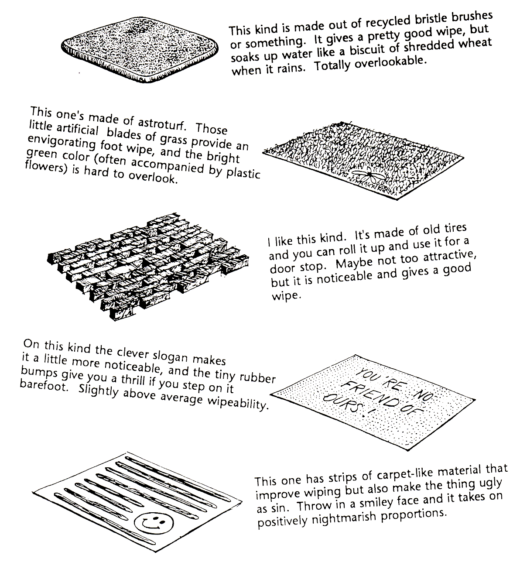
[above: Doormat Reviews from Nancy’s Magazine, Issue #6. Click here to see the entire page in context.]
MARK: So Nancy’s Magazine was a vehicle through which you could express your child-like awe at everything around you, even the mundane and ordinary?
NANCY: Yes, a kind of awe — but I would never use the term “child-like awe.” I don’t think that does children or awe justice. I think I wanted the magazine to be fierce, swooning, irreverent, highly observant, and playful – and promote a frugal approach to living. Maybe all that adds up to a celebration of the “ordinary”!
MARK: Do you know the circumstances of your birth?
NANCY: Ha! Are you hoping to correlate a certain birth circumstance with zine creation? I came out of my mother’s birth canal in a hospital in Portland, Oregon. I was robust and healthy, and I’ve been told everyone (with perhaps the exception of my older brother) was pleased. A super fortunate beginning.
MARK: Having talked with a few dozen zine folks for this series, I’ve been able to identify a few common characteristics — crippling loneliness, social anxiety, a sense of never fitting in, nascent narcissism, etc. — but that’s not why I asked about your birth story. I just find that it’s a good way to start a conversation about one’s youth. For instance, had you asked me the same question, I would have responded with something like, “My dad was in the military, somewhere in Virginia, having been recently drafted to serve in Vietnam. So my mom was living with her parents in Kentucky when I was extracted from her. And that’s how she’s described it to me. She’d been drugged by her doctors, and I was pulled through the birth canal before I was ready, with forceps, which were apparently clamped down on my head. When she came to, and they handed me to her at the hospital, she pushed me away saying, ‘That’s not mine, I haven’t had my baby yet.’” Well if you’d said something like that to me, I would have likely responded with something like, “Damn,” and then gone off on a tangent about your relationship with your mother… Instead, I’ll ask about Portland. What was it like growing up there, and what were the circumstances around your leaving?
NANCY: Wow! What a beginning for you and your mom! I can’t quite explain why I loved Portland so much, because my family left when I was about six-and-a-half, when my father got a job at The Ohio State University. In Portland, we lived on a hill, surrounded by rhododendrons that I remember as being lush and leathery. In elementary school in Ohio, I thought of myself as one who had been wrenched from her homeland. Ha! Oregon was the 33rd state admitted to the Union, so my favorite number was 33, etc. And I have been back several times – even to visit that house on the hill. And it IS lush and gorgeous.
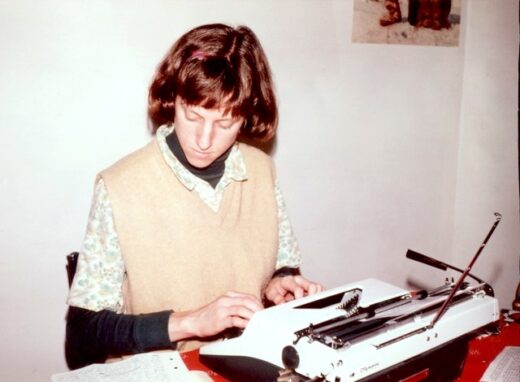
[above: Nancy Kangas working in her San Francisco apartment, circa 1984.]
MARK: You mentioned your father was a psychologist. What kind of psychologist was he? And what did your mother do?
NANCY: My mother has had a host of jobs, starting with teaching 3rd grade, and finishing up with tax accounting. My father was a clinical psychologist who really just wanted to be a hobo.
MARK: When you say your dad wanted to be a hobo, I’m assuming you don’t mean that he just dressed like a tramp, right? Did you get the sense that he was always thinking about the possibility of jumping on a passing train, and running away?
NANCY: No, he didn’t actually dress like a hobo. It’s more like he was one in his soul. He was the son of Finnish peasants (or at least that’s how he describes it – and it pretty much checks out), and always made a point of reminding us how odd it was for him to appear in this domesticated world, where we ate with knives and forks, instead of right out of the can, and where there was this odd emphasis on bathing and hygiene.
MARK: Did you ever meet your Finnish grandparents?
NANCY: Yes. I felt very close to them, especially my grandmother. We wrote letters to each other regularly for 40 years. (We never lived in the same state.) Her letters were preachy, and mine were braggy, but there we are. (I saved all of hers and she gave me back all of mine! So I have evidence.) But throughout her life I never stopped wanting to know who she was.
MARK: Assuming she gave you advice, what was the best advice she ever gave you? Or, if nothing comes to mind, I’d accept a scan from one of her letters. It doesn’t really matter about what. I’m just interested to hear her voice.
NANCY: My main memory is that she wanted me to work hard. And also stop working so hard. (Ha! I think that’s what she would have told herself – but I’ll find a letter and scan it and see if I’m remembering right.)

[above: An excerpt from a letter sent to Nancy by her grandmother, Olga Hill, in 1988.]
MARK: What’s your first memory?
NANCY: Being held on the soft lap of an adult babysitter, full of free-floating resentment. I stared at her penny loafers — she had put pennies in them, and I was envious and spiteful. These loafers also had fringe. I’d just had orange juice, and felt like throwing up. I think I was four.
MARK: While it’s true that I’ve never seen a copy of Nancy’s Magazine, I do have a copy of Chip Rowe’s Zine Book, and I’ve read the excerpts from Nancy’s Magazine that were reprinted there. In the book, you describe yourself as a librarian. Were you a librarian when you started Nancy’s Magazine, or did that happen later?
NANCY: No, I wasn’t a librarian when I started the magazine. Not too long after I started the magazine, though, I got a job as a “page” at the Eureka Valley Harvey Milk Memorial Branch Library of the San Francisco Public Library system. I loved it there… I was in love with public libraries in general. I’d make an adventure out of picking library branches to visit, spending hours at them, and writing thesis-free personal-essay/reviews of each one… Eventually, I’d go to library school, and land my dream job — being a reference librarian at Columbus Metropolitan Library. I was there for 30 years. A good run.
MARK: Is the Eureka Valley Harvey Milk Memorial Branch Library the only library in the United States that has a page program? In my lifetime, I’ve only heard of pages being used in Congress and the big three television networks.
NANCY: I think “page” was the actual job title. (Now we call them something like “Customer Service Associates”.) It was the job you could get with a high school diploma. You needed to know the alphabet, and be comfortable with alphabetization.
MARK: Did Nancy’s Magazine help you get the page job?
NANCY: At first at least I probably did everything I could to conceal the fact that I was working on the magazine. I am sure I didn’t want to appear odd (as if that could be hidden!). I stayed there for years and loved that job to pieces, and also my boss, Flo, who was a grizzly bear on the outside, and a kitten on the inside. I came in one day and told her I’d quit my studies at SFSU, and, by the end of the shift, she’d turned me around and got me back in.
MARK: In “The Book of Zines,” you had what I think is a really great quote about why you started “Nancy’s Magazine”… or the tone you were trying to strike. You said, “I longed to read a magazine that combined the meatiness of Scientific American with the sassiness of National Lampoon. It just didn’t exist, so I had to make it.” Does that still ring true?
NANCY: YES.
MARK: When did you become aware of zine culture?
NANCY: When I started Nancy’s Magazine in 1983 (in San Francisco), I was mostly reacting to mainstream magazines (Mad, Scientific American, Better Homes & Gardens). But somewhere, I’d found Wet: The Magazine of Gourmet Bathing — and it changed everything for me. Wet had the production qualities of a mainstream title, but featured art, artists, and rampant silliness. Wet was like being at a crazy party (in the best way). All of this is to say, I think I was oblivious of “zine culture” when I got started.
MARK: So, when did you become aware that there were other individual people out there, self-publishing about their lives?
NANCY: There was a “punk shopping mall” that opened up on 16th St. in the Mission, in San Francisco. They sold N’sM — along with other homemade publications. So I must have been figuring out that there were others out there doing something like what I was.
MARK: Did you identify as a “punk” at the time?
NANCY: No. Punks (to me, at that time) seemed to want to tear up their clothes, and I was into sewing them. Ha! Nowadays, though, I sometimes call myself “punky” because it helps explain my relationship to what I consider the mainstream.
MARK: Would it be around this time that you first became aware of Factsheet Five?
NANCY: Factsheet Five was how I *really* knew there was a zine culture — it was the catalog of everything that mattered. Ditto for OP out of Olympia.
MARK: Do you remember the first time you saw an issue of FactSheet Five?
NANCY: Not really – although I just found my early copies.
MARK: Do you still have all of your old zines and correspondences?
NANCY: I recently donated all the letters I’ve received and zines I’ve saved, along with drafts of each issue, to the Rare Books and Manuscripts Library and The Ohio State University. So, as of right now, you can search “The Nancy Kangas Papers.”
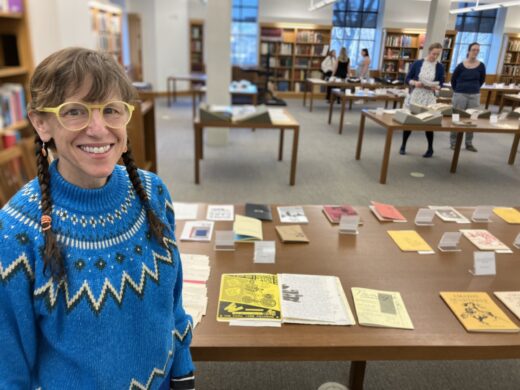
[above: Nancy in 2024, presenting her work at The Ohio State University’s Rare Books and Manuscripts Library.]
MARK: That’s great. Did they reach out to you, or did you find them? And do you have a sense as to when everything might be online, and available?
NANCY: I told a friend I was fretting over what I should do with this stuff – and they suggested I call. And I’m glad I did. I’m guessing it will be available sometime this year (in 2024).
MARK: Were you selling Nancy’s Magazine anywhere else in San Francisco, other than the place in the Mission that you mentioned?
NANCY: In the beginning, I sold Nancy’s Magazine at record stores (like Aquarius Records), because, at that time, there were lots of little magazines that reviewed records and shows — and you bought them at record stores. N’sM didn’t really fit there, but people were nice about it. And it didn’t fit with literary magazines — but City Lights agreed to carry it, too.
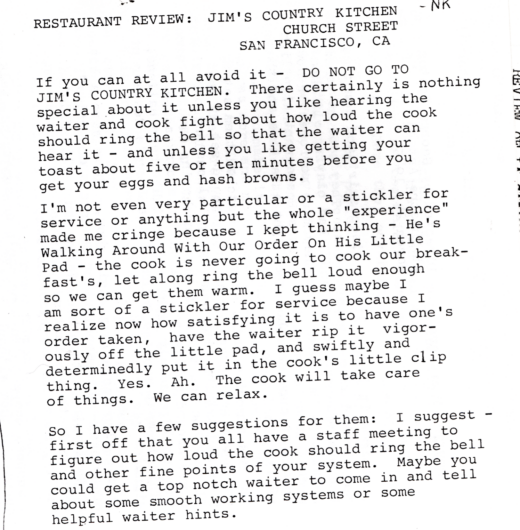
[above: A review of Jim’s Country Kitchen from Nancy’s Magazine, Issue #1, 1983.]
MARK: Do you remember any of the zines that you were reading at the time?
NANCY: Bunny Rabbit (by Amy Fusselman), Op (mostly music-based magazine), and King Cat (by John Porcellino) – and so many more.
MARK: When I interviewed Amy Fusselman for this series, she mentioned that she played in a punk band that once opened for The Minutemen. I felt as though I should share that factoid, as I know you were in a band as well.
NANCY: Awesome. Punky writers are the best.
MARK: Stepping back a bit, can you talk about what brought you to San Francisco in the first place?
NANCY: I had just quit studying at OSU Music School – I thought I was going to be a concert pianist. I was pretty good, but not that good. I loved practicing, but I was missing *doing* something for people. So I got a job as a waitress. But then I missed making things. Then a friend said she was moving to the Bay Area for the summer. So I thought, “Hey, I’ll move to San Francisco and be a carpenter’s apprentice.” In my tiny studio apartment in Columbus, I called up every carpenter in the San Francisco Yellow Pages until I found one (Fred Smith) who hired me over the phone.
Our band, The Naked Skinnies, had kind of broken up by then, so it was a good time for a new direction. Greg (Bonnell) said he’d always wanted to surf, and asked if he could come along. He had a car, so it seemed like a great idea.
MARK: What can you tell me about the Naked Skinnies, and your role in the band?
NANCY: I’d describe us as folk-punk, perhaps with a whiff of New Wave. I played toy piano and a little, wheezy organ; I wrote songs and sang them. So did Mark Eitzel. He was wayyyyyy better at it than I was, but I had no idea of this at the time.
MARK: What year would this have been? And what was the punk scene like in Columbus at the time?
NANCY: That was 1980. I was only marginally aware of Columbus’ punk scene at the time. I guess I knew there were bands with tough-sounding names and scrappy looking fliers. Uh, like ours. And we all played at the same two clubs!
MARK: OK, so I looked up Mark Eitzel’s name in an unfruitful attempt to find a Naked Skinnies song online somewhere, and found the following on Eitzel’s Pandora page.
…A few months later, Mark’s family returned to the United States and settled in Columbus, Ohio, where Mark enrolled at Ohio State University. At OSU, Eitzel bonded with members of Columbus’ tiny punk rock community, and joined a band called the Cowboys. While the Cowboys initially played only covers of well-known punk favorites, in 1980 they cut a single of two original tunes, “Teenage Life” b/w “Supermarket,” which became Eitzel’s first commercially released recording. Only a few months after releasing their 45, the Cowboys broke up, and Eitzel formed a new group, the Naked Skinnies, with Eitzel on guitar and vocals, Nancy Kangas (whom Eitzel would call his muse and who became a figure in a number of his songs) on organ, John Hricko on bass, and Greg Bonnell on drums. The Naked Skinnies released a single in 1981, “All My Life” b/w “This Is the Beautiful Night,” before moving to San Francisco. While the Naked Skinnies gigged occasionally in California, their recordings disappeared in a robbery at the band’s house, and after Eitzel angered local music promoter Dirk Dirkson with a deliberately confrontational performance, they were blackballed from most San Francisco venues, leading to the group’s breakup in 1982….
I just want to be sure I have the timeline right. You were in the Naked Skinnies in Columbus, and then the whole band relocated to San Francisco, breaking up there…
NANCY: Yes: the Naked Skinnies formed and played in Columbus. We broke up – mostly because Greg and I moved to SF. But then Mark and John moved out to SF and we started up again.
MARK: Back to that clip from the Pandora page… I’m curious as to what you think of the title of “muse”?
NANCY: I’m glad you asked, because they’ve got it wrong. Mark had a muse, but it was Katherine, a friend of his (and of the band’s). She also eventually moved out to SF.
MARK: So you and Greg, it seems, are responsible for a lot of people making their way from Ohio to San Francisco.
NANCY: Ha! I make it sound like that! But it was probably the pull of the West and the call of wanting to be Real (more real than we felt we could be in Ohio) that was a bit stronger than me and Greg.
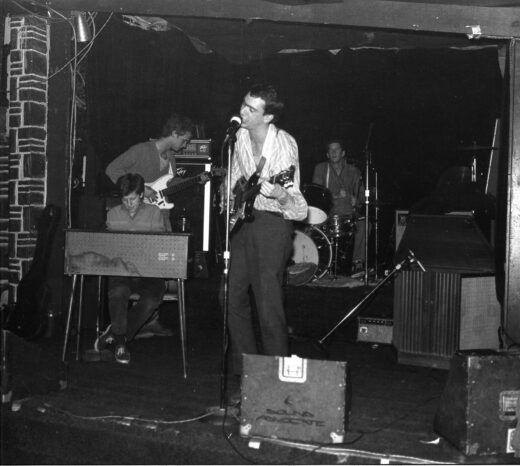
[above: The Naked Skinnies; Nancy Kangas (sitting), John Hricko, Mark Eitzel, and Greg Bonnell. Playing at Stache’s (Columbus), circa 1981.]
MARK: I promise I won’t go on too much longer about the band, but I have to ask about this “deliberately confrontational performance” that got you banned from almost every venue in San Francisco.
NANCY: Well, that’s a bit of an overstatement. We had one show where Mark got mad at a heckler (one of just a handful of people in the audience!) and probably said something angry to him. I think Mark stormed out, and we kinda looked silly up there without him. I don’t remember being banned as much as being tired of playing clubs where people were heckling us.
MARK: Performing live can be terrible. I was once in a band that got maced while performing.
NANCY: Yikes – ouch!
MARK: And what’s this about a robbery? Someone broke in and stole your recordings?
NANCY: Yes. They sure did – steal our gear. (I don’t remember if they stole our tapes, too.) And that sure sucked. We got some of it back, because we looked in the basement window of our neighbor’s house, and there (some of) it was.
MARK: Was another band living there, next door?
NANCY: Alas, not a band. But a batch of seemingly-unsupervised teenagers, who took our stuff – or had friends who did.
MARK: OK, back to Nancy’s Magazine… Do you think, if you’d been aware of zine culture earlier, you would have called the publication Nancy’s Zine when you started it?
NANCY: I never got comfortable with the word “zine” (just as I still don’t care for the word “veggie”). It always feels like we are trivializing something grand. But yeah, I know, “little magazine” is just not going anywhere.
MARK: I mentioned Doug Biggert at Tower Records earlier. Given how effusive he’s been with me on the subject of Nancy’s Magazine in the past, my impression is that he and Tower got behind it in a big way. Can you talk a bit about your relationship with Doug?
NANCY: I remember getting a call from Doug at Tower, and he asked to be sent 200, or maybe 300 issues — which was an INSANELY big order for me. Game changing, really — because he was sending them to all the Tower Record stores here and in London. The magazine started to reach new readers. I was lucky to meet Doug in person many years later, when he came through Columbus — and got to find out he’s a wild and wonderful human. We kept in touch until he passed.
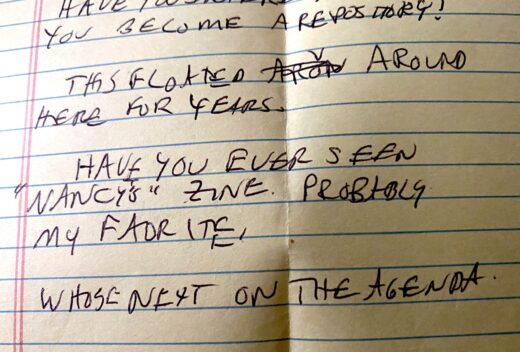
[above: Letter from Doug Biggert encouraging me to interview more people for this series, and suggesting I reach out to Nancy Kangas.]
MARK: You were kind enough to just send me a scan of the first issue, and, based upon the questions you posed to your friends in that issue, I now have a few things that I’d like to ask you…. Have you ever thought about changing your name?
NANCY: In second grade I began signing my papers, “Sylvia Kangas.” “Nancy” seemed so hamfisted and prosaic. I longed to be something elegant and swanlike, and thought “Sylvia” was the ticket. It didn’t stick.
MARK: We heard about Mrs. Weaver at Crestview Jr. High, but do you remember who your favorite elementary school teacher was? And do you think they’d remember you?
NANCY: Mr. Luther, sixth grade. He was radical. It was his first year teaching – and it seemed everything was an experiment – from how we lined up after recess, to how he rewarded us for working. And after our year he quit! For that reason, I’d hope he’d remember all of us. I would so like to talk to him again.
MARK: If your elementary school had a reunion – like a 6th grade class reunion – would you be tempted to go?
NANCY: I’m there. I would organize a “friendly” tetherball tournament – you know, just to see who’s still boss.
MARK: There was a lot of talk in that first issue of fashion, with you breaking down your wardrobe, giving advice on belt-making, etc. How would you describe your fashion sense at the time? And would you say that this self-portrait was a fairly good representation of what you were like back then, fashionwise?
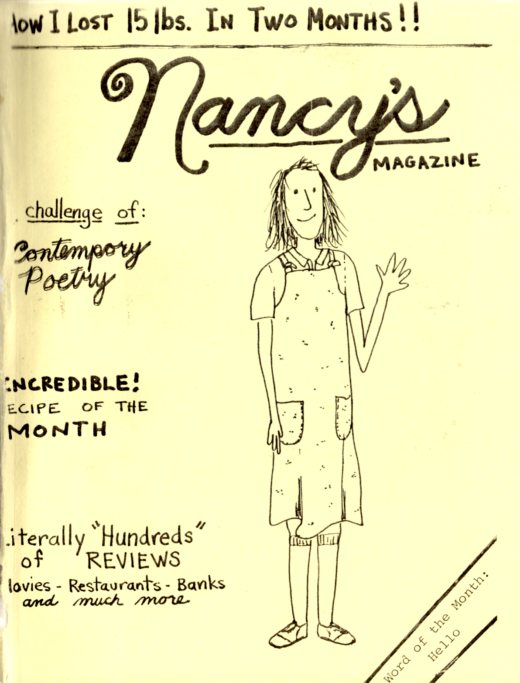
[above: The cover of Nancy’s Magazine, issue #1, 1983.]
NANCY: That is precisely how I looked. I made the blouse and I don’t really have eyebrows. I’d like to think I’ve changed my fashion game over time, but, heh, I think I’ve been holding steady since (oh dear) 7th grade. (I still wear a few things from then!) I love to dress just this side of “clown” – and dare myself to get as close to that edge as I can without falling over.
MARK: Did you include fabric swatches in some issues of Nancy’s magazine?
NANCY: Yes. In the Mood Issue – in a “Handy Reference Guide” of the article, “Polyester Pull-out,” which I hoped to answer all our pressing questions about polyester in fabrics. I wanted readers to be able to feel (I mean really feel) the difference between cottons and blends.
MARK: What was your favorite piece of clothing as a child?
NANCY: Not sure if it counts as a “piece of clothing” but I never felt better than when I had ribbons tied into bows at the end of my braids.
MARK: What’s the best thing to come from your experience with Nancy’s Magazine?
NANCY: Oh! So many good things. The best things (for me) are always relationships – that somehow the magazine led me to meet people who become people I hung out with or wrote to for years, people I traveled miles to visit. I mean, that’s amazing. And I didn’t even intend for that to happen. Another thing (this is probably more fantasy than reality): I remember walking down the street in San Francisco and someone is coming towards me and they say, “Hey, are you the person who does Nancy’s Magazine?” (I say yes.) And they look at me like they really REALLY know me, and they like me – in the same way I like myself. Recently I heard poet Sam Sax say that he writes poems as if he were writing to a beloved (and his poems reek with crazy wild love!), and I realized that’s how I approached writing for Nancy’s Magazine. I wish I could do that now. I would be so much happier. My writing would be so much better.
MARK: Why do you think that is? Why do you think that you’re more guarded in your writing now? Is it just something that happens to everyone with age?
NANCY: Ay, I hope not! But maybe it’s not so much about age, as time in the art-making saddle. There’s a name for this arc that I’m forgetting: in the beginning you don’t know what you don’t know, and so are free to romp about and be awkward and wild. Later you know so much more (about your craft, about how others approach it), and that awareness can weigh you down. Now I have to find a way to bow and say thank you to all that knowing and exit to a room with just myself. I haven’t figured out how to do that yet.
MARK: How personal did you get in Nancy’s Magazine?
NANCY: Sometimes very – but to my ear, it never had a confessional feel. For instance, in an early issue I drew a comic that showed I’d lost an enormous amount of weight by not eating. It was a fact – an alarming one, and I don’t even think I realized I was revealing an eating disorder.
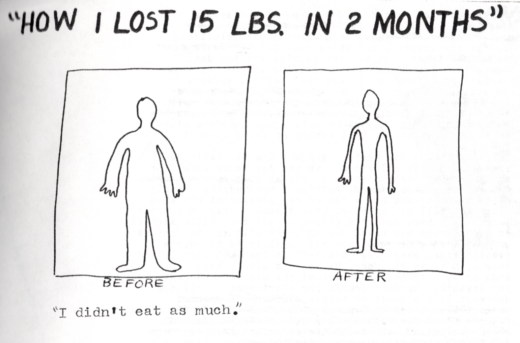
[above: From Nancy’s Magazine, Issue #1.]
MARK: Was there a line for you? Were there personal things that you wouldn’t write about?
NANCY: Yes, but I don’t think I understood where the line was. (I still don’t.) At the time I avoided writing directly about romantic heartbreak, although I stuffed all poems full to bursting with metaphorical images of despair. I was so good at not being direct, I doubt any reader ever had a clue I was being intensely personal.
MARK: Is there anything about Nancy’s Magazine that you’d do differently, if you had a chance to go back?
NANCY: Maybe I’d wish it to be less crowded, visually. And maybe less verbose. But there it is: a document of what I thought needed to be said. (So – no.)
MARK: How many issues of Nancy’s Magazine did you put out, and over what period of time?
NANCY: Thirteen, from 1981 to 1996.
MARK: Do you have a favorite story that you shared in Nancy’s Magazine?
NANCY: It’s between the “Landmarks in Lawncare” pullout poster (I really feel I did that history justice – wasn’t overly prescriptive, yet revealed our march to lawn-hell speak for itself) – and the early bit about how when you put a hand-drying towel up high, all the water from your just-washed hands dribbles down your arms. I have always felt like that was the last word on towel-placement.
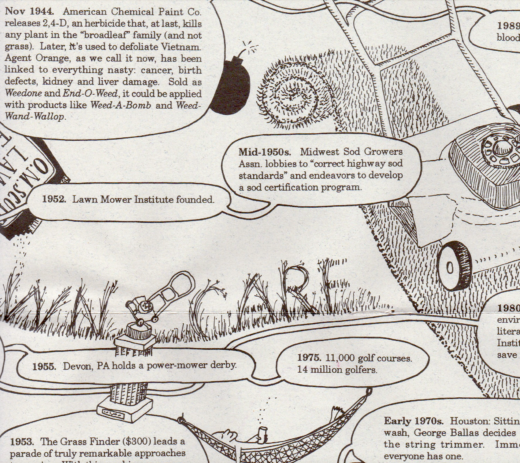
[above: An excerpt from Landmarks in Lawncare, Nancy’s Magazine, Issue #13. Click here for the full left side and right side of the poster.]
MARK: Can you give us an example of one interesting person who came into your life as a result of Nancy’s Magazine?
NANCY: It’s so hard! Because so much of my life during this time was how the magazine was a portal for interesting people and kindred spirits. But I’ll mention my friend Daniel, who visited me in Ohio from San Francisco in the early 90s – knowing me only through the magazine. He’s been a dear friend ever since. Ah and there’s Paul! A poet whose poem I accepted for N’sM (super rare) and became someone I considered my poetry mentor, and a friend.
MARK: What happened with your carpentry internship?
NANCY: I lasted 6 months. Then Fred Smith offered me the job of being his accountant. (I often joke that I was the only one in the shop with all ten fingers. haha.) I still wish I knew carpentry and was a builder, but I also know my scrawny frame does not make that dream an easy one to pull off.
MARK: And, at some point you left San Francisco, and came back to Ohio. But you kept publishing for a while. Were those issues different in tone?
NANCY: Interestingly – not that I can tell!
MARK: If you had to put out a new issue of Nancy’s Magazine right now, what would it look like?
NANCY: I’ve been thinking about this question a lot. And here it is: it would be the same exact format – print, saddle-stitch, minimal color but some color for sure, 8.5” x 7” – with some paper prize inside!!! In the early 2000s, there was all this energy around maybe starting it up as a website. Heavens I’m glad I never did that. I love paper. I love holding a magazine. I’d do it again, if I didn’t have so many other projects on my plate and so few years to do them.
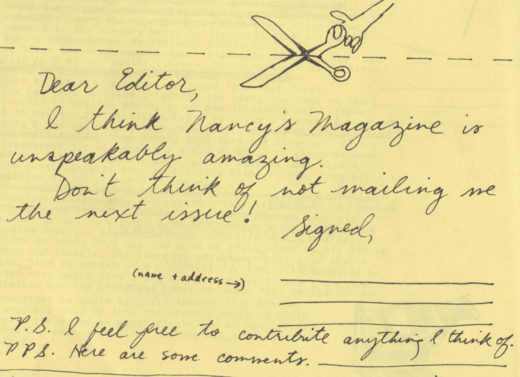












3 Comments
My favorite issue had a composite photo of all possible typical heartthrobs. It was glued to the back of the zine .
I only read 1 N’sM issue. It contained an article about the differences between hummus and humous which I will never forget. PS I was also a Page (CML North branch).
My FB avatar is based on a cache of vintage pet food labels that Nancy was kind enough to send me after we met at Bumbershoot in 1996. She remains one of my all time fanzine heroes.